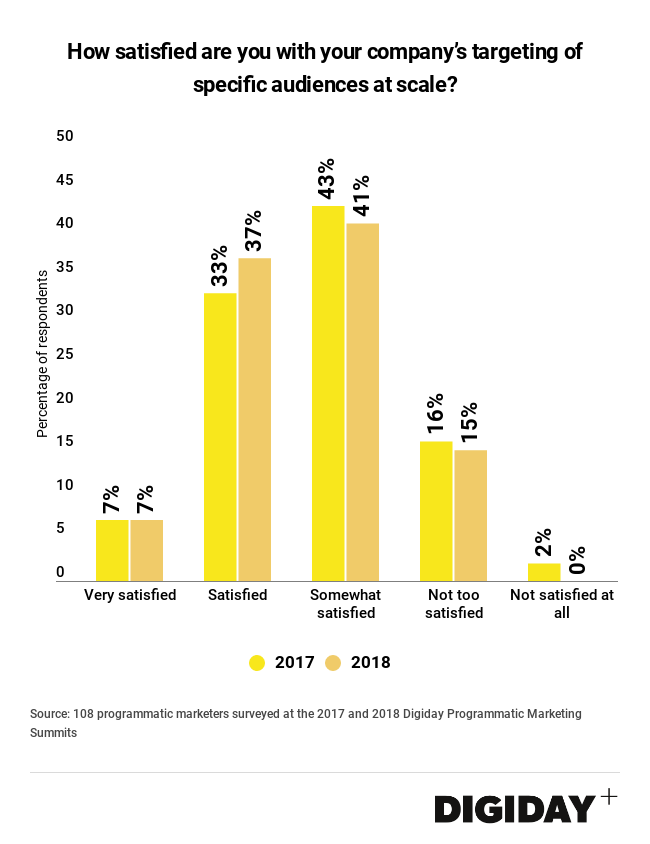Save 50% on a 3-month Digiday+ membership. Ends Dec 5.
Digiday Research: Marketers say audience-targeting capabilities are improving

This research is based on unique data collected from our proprietary audience of publisher, agency, brand and tech insiders. It’s available to Digiday+ members. More from the series →
The “holy grail” for marketers has always been the ability to target ads to specific and granular audiences at scale. As it stands currently, some marketers are still wasting their efforts mistakenly advertising to women instead of men or sending ads for alcoholic beverages to underage kids.
Though there’s clearly room for improvement, marketer satisfaction with their companies’ ability to target their ads continues to improve, according to Digiday’s research.
Of the 46 marketers surveyed at the Programmatic Marketing Summit this past June, 44 percent said they were satisfied with their companies’ targeting ability. That’s a tick up from 40 percent the year prior. Meanwhile, no marketers labeled themselves as not at all satisfied compared to 2 percent of marketers who did in 2017.
One factor hampering marketers’ targeting capabilities is quality third-party data. Marketers cited it as the biggest challenge to using data in ad campaigns and 82 percent of marketers don’t believe it’s reliable. One anonymous attendee to the summit admitted they were under “more pressure to use more first-party data and step away from third-party data” for that reason.
For mobile advertising, which is driving much of the growth of digital advertising, a lack of transparent data also remains an obstacle for marketers.

Beyond third-party data, platforms can have an impact on marketers ability to target audiences at scale. Facebook is a major destination for marketers ad dollars, so it would be understandable if marketers were less optimistic about their audience-targeting capabilities due to Facebook recently shutting off the third-party data that was available. However, companies have begun to sour on the social media giant. One attendee at the recent Digiday Content Marketing Summit labeled it a “customer service platform,” and not a platform for marketing.
Instead of platforms and third-party data, location targeting is one area that marketers are seeing success in and could be responsible for their slightly upbeat attitudes. Eighty-seven percent of marketers have found positive results using location data and marketers listed reaching scalable audiences as one the top three benefits of location marketing, according to a survey by Factual. Additionally over 60 percent of marketers in the same report said location targeting lead to more accurate audience targeting.
Location-based advertising alone won’t remedy marketer’s issues when it comes to their ability to target audiences at scale. Without a greater industry emphasis on more transparent and accurate third-party data, improving marketers’ satisfaction with scaled audience targeting will continue to be an uphill battle.
More in Marketing

Behind the rise of the chief productivity officer and what it means for companies and employees
The CPO is envisioned as the leader who orchestrates people and technology together to drive business outcomes.

OpenX redraws the SSP-agency relationship
The gradual realignment of programmatic’s middlemen discussed at Digiday’s Programmatic Marketing Summit.

Omnicom’s reshuffled leadership emerges as the ad industry’s new power players
Omnicom’s Black Monday saw thousands of jobs cut, and a chosen few put in charge of what is now the world’s largest marketing services group. They face a number of challenges, however.





